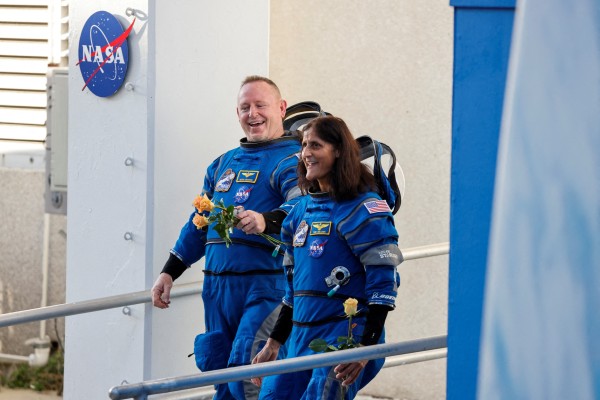Boeing’s new Starliner capsule and its inaugural two-member NASA crew docked with the International Space Station on Thursday.
The spacecraft, roughly 200 metres away from the space station, missed an initial time window for docking with the orbital laboratory as mission managers in Houston investigated the failure of some spacecraft thrusters used for precise manoeuvring.
Starliner docking confirmed!
The #Starliner crewed spacecraft docked to the @Space_Station at 1:34pm ET with @NASA_Astronauts Butch Wilmore and Suni Williams. pic.twitter.com/rTzuUHdABm
— NASA’s Johnson Space Center (@NASA_Johnson) June 6, 2024
The CST-100 Starliner, with veteran astronauts Barry “Butch” Wilmore and Sunita “Suni” Williams aboard, was due to arrive at the orbiting platform after a flight of roughly 25 hours following its launch from Cape Canaveral Space Force Station in Florida.
The reusable gumdrop-shaped capsule, dubbed “Calypso” by its crew, was lofted into space on Wednesday atop an Atlas V rocket furnished and flown by Boeing-Lockheed Martin’s United Launch Alliance joint venture.
It was originally scheduled to autonomously dock with the ISS some 400 km above Earth at approximately 12:15 p.m. ET (1615 GMT).
The spacecraft’s approach to the ISS was livestreamed on a NASA webcast, which showed video images of the capsule captured by a camera aboard the space station.
#Starliner’s innovative navigation and docking system called the Vision-based, Electro-Optical Sensor Tracking Assembly, or VESTA, acts as the “eyes” of the spacecraft on orbit, determining the location and orientation of the vehicle relative to the stars around it. pic.twitter.com/qrfwIv63Cv
— Boeing Space (@BoeingSpace) June 6, 2024
Once securely coupled to the space laboratory, Wilmore and Williams conducted a series of standard procedures before opening the entry hatches. These include checking for airlock leaks and pressurizing the passage between the capsule and the ISS.
They were welcomed aboard by the outpost’s current seven resident crew members: four fellow U.S. astronauts and three Russian cosmonauts.
Wilmore and Williams will remain aboard the station for about eight days before their return flight. Starliner’s fiery re-entry through Earth’s atmosphere and a parachute and airbag-assisted landing in the U.S. Desert Southwest will be a first for a crewed NASA mission.
On its voyage to the ISS, helium leaks were detected on Starliner’s propulsion system, knocking out some of the 28 thrusters used by the capsule to manoeuvre in space.
Starliner uses helium to add pressure to the propellant for its thrusters. NASA and Boeing did not specify the positions of the downed thrusters or how quickly helium was leaking.
NASA mission managers early on Thursday morning gave Boeing the green light to proceed to rendezvous.
Last-minute glitches had nixed the Starliner’s first two crewed launch attempts, including a helium leak found on the capsule’s propulsion system that officials later determined was not serious enough to warrant a mechanical fix.
NASA and Boeing officials at the time pointed to a faulty seal on one thruster component that was failing to keep the helium inside.
Boeing built Starliner under contract with NASA to compete with SpaceX’s Crew Dragon capsule, which since 2020 has been the U.S. space agency’s only vehicle for sending ISS crew members to orbit from American soil.
The current mission marks Starliner’s first test flight with astronauts aboard, a requirement before NASA can certify the capsule for routine astronaut missions.
Selected as crew for the pivotal flight were two NASA veterans who have previously logged 500 days in space between them: Wilmore, 61, a retired Navy captain and fighter pilot, and Williams, 58, a former Navy helicopter test pilot with experience flying more than 30 different aircraft.
Getting Starliner to this point has been a fraught process for Boeing under its $4.2 billion, fixed-priced contract with NASA, which wants the redundancy of two different U.S. rides to the ISS.
The Starliner is several years behind schedule and more than $1.5 billion over budget. Meanwhile, Boeing’s commercial airplane manufacturing operations have been rocked by a series of crises involving its 737 MAX jetliners.
(REUTERS)
In a career spanning three decades and counting, Ramananda (Ram to his friends) has been the foreign editor of The Telegraph, Outlook Magazine and the New Indian Express. He helped set up rediff.com’s editorial operations in San Jose and New York, helmed sify.com, and was the founder editor of India.com.
His work has featured in national and international publications like the Al Jazeera Centre for Studies, Global Times and Ashahi Shimbun. But his one constant over all these years, he says, has been the attempt to understand rising India’s place in the world.
He can rustle up a mean salad, his oil-less pepper chicken is to die for, and all it takes is some beer and rhythm and blues to rock his soul.
Talk to him about foreign and strategic affairs, media, South Asia, China, and of course India.





